Drawing from the experience of collaborative approaches to build resilience and improve water security in Maharashtra and Uttar Pradesh, supported by the 2030 Water Resources Group (2030 WRG), Meghana, Yogesh and Pia provide recommendations for agricultural extension services to improve water security for agriculture in this blog.
CONTEXT
“When the well is dry, we know the worth of water.” This quote by Benjamin Franklin depicts a harsh reality that most communities across the world are starting to recognize. As India celebrates its 75th Independence Day and with World Water Week – 2022 recently concluded, it is important to acknowledge the importance of our rivers, lakes, oceans, and glaciers in building our civilizations, and supporting our agriculture, industries, and communities.
The agriculture sector accounts for almost 90% of the total water consumption in India, with high dependence on groundwater in addition to surface water resources.[1] In 2021, the Global Climate Risk Index ranked India as among the top 10 countries most affected by climate change[2] and projected to face severe water stress by 2050[3]. With 17%[4] of water blocks categorized as ‘over-exploited’, 70%[5] of India’s surface water being contaminated, and high NRW losses (around 40%[6]) in the water system, access to safe and assured sources of water continues to be a challenge. This is owing to a multitude of issues and inefficiencies in governance and management, end use, monitoring and conservation of water resources.
The negative impacts of climate change are intensified by the agriculture sector’s extreme vulnerability to it, leading to shifting agro-ecosystem boundaries and invasive crops and pests. Scientists project that a 2.5o to 4.9o C increase in temperatures across India could lead to a decrease of 41% to 52% in wheat yield and 32% to 40% in rice. Crops, such as maize and sugarcane, are equally impacted.[1] With total water demand in India expected to rise by over 70% by 2025[2], a huge demand-supply gap is expected. This can be managed only with the adoption of climate change adaptation strategies that build resilience and incorporate water management through collective and multi-stakeholder action.
BUILDING RESILIENCE AND IMPROVING WATER SECURITY IN AGRICULTURAL ECOSYSTEMS
Two collaborative approaches – supported by 2030 WRG (Box 1) – to build resilience and improve water security in Maharashtra and Uttar Pradesh are discussed below.
|
Box 1. 2030 Water Resources Group In India, the Multi-Stakeholder Platforms (MSPs) established by 2030 WRG in Uttar Pradesh and Maharashtra drive the agenda of stakeholder-driven collective action to ensure water security, by bringing public, private and civil society partners together. To this end, 2030 WRG is working to design transformative projects around the climate-water nexus by promoting a shift towards climate-smart agriculture. |
Maharashtra
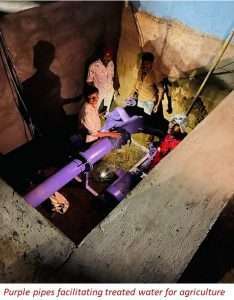 Agriculture and allied sectors contribute to around 12% of Maharashtra’s economy and are responsible for around 68%[1] of the State’s labour force. Around 80%[2] of agriculture in Maharashtra is rainfed, and farmers depend on seasonal rains for their livelihoods. With two-third of the state’s area facing high to moderate levels of vulnerability,[3] the agricultural ecosystem in Maharashtra is affected by climate change-induced droughts, floods, and shifting precipitation patterns. The area under cultivation for food grains reduced from 74% in the 1960s to 52% in 2020.[4] During the same period, the area under cultivation for water-intensive cash crops increased from 24.8% to 46%.10 This shift has led to the depletion of groundwater resources and imposed health risks owing to the consumption of polluted water from streams and canals.
Agriculture and allied sectors contribute to around 12% of Maharashtra’s economy and are responsible for around 68%[1] of the State’s labour force. Around 80%[2] of agriculture in Maharashtra is rainfed, and farmers depend on seasonal rains for their livelihoods. With two-third of the state’s area facing high to moderate levels of vulnerability,[3] the agricultural ecosystem in Maharashtra is affected by climate change-induced droughts, floods, and shifting precipitation patterns. The area under cultivation for food grains reduced from 74% in the 1960s to 52% in 2020.[4] During the same period, the area under cultivation for water-intensive cash crops increased from 24.8% to 46%.10 This shift has led to the depletion of groundwater resources and imposed health risks owing to the consumption of polluted water from streams and canals.
To address the dual challenges of water access and health risk in water for agriculture, 2030 WRG’s Maharashtra Water Multi Stakeholder Platform (MSP) implemented a pilot project in Zalta, Aurangabad, with the Aurangabad Municipal Corporation (AMC) and Project on Climate Resilient Agriculture (POCRA)[1] for circular solutions to build water security in the region. Through the conveyance infrastructure set up by local farmers, safe treated wastewater from the Zalta Sewage Treatment Plant is reused for agricultural applications in adjacent areas. Apart from organizing farmers in a first-of-its-kind Wastewater User Association and providing them with an assured source of water to increase incomes, this approach enabled AMC to better utilize the treated wastewater as a resource for revenue generation.
Globally, purple pipes signify the flow of treated water. Through this ‘Purple Revolution’ in the use of treated water for agriculture, a prototype for collective action to address water scarcity issues that threaten agriculture in India has been demonstrated. The National Framework for Safe Reuse of Treated Water issued by the Ministry of Jal Shakti, Government of India, lays out the vision, mission and path for implementation of programs and approaches at both state and national level for scaling up such projects.
Uttar Pradesh
The Bundelkhand region in Uttar Pradesh is characterized by strong underlying risk factors such as persistent water scarcity, poor soil fertility and low productivity that are further intensified by climate-induced vulnerabilities.
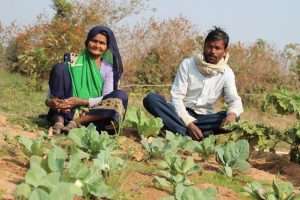 Villagers with additional harvest using water conserved under Project PRAGATI
Villagers with additional harvest using water conserved under Project PRAGATI
2030 WRG’s Uttar Pradesh MSP conceptualized the PRAGATI[1] Project to ensure water, livelihood and agricultural security while mitigating climate-induced risks. Collective efforts through convergence between the government, private sector and civil society for development of village-level water security plans, water budgets, and rejuvenation of water bodies have led to effective management of water resources. Using a participatory approach, communities have been mobilized to play a central role in managing their water needs. ‘Jal Sahelis’, a cadre of women water warriors have played an instrumental role in coordinating water-related work in villages.
As a part of convergences facilitated, PRAGATI has integrated benefits from relevant departments under the Government of Uttar Pradesh, including Rural Development, Mahatma Gandhi National Rural Employment Guarantee Act, National Bank for Agriculture and Rural Development (NABARD), and Members of Parliament Local Area Development Fund. Private partnerships have also been leveraged for PRAGATI, including those with GIZ, Indian Agriculture Incubation Network (IAIN), Social Alpha, Dalmia Bharat Foundation and other development organizations, such as Parmarth Samaj Sewi Sansthan for implementation support.
Executed on 8000 hectares, it is estimated that PRAGATI has led to 4.8 million liters of water conserved, and 61.82 million liters of freshwater abstraction avoided due to improvements in on-farm water-use efficiency from 2020-21.[2] Considering the project’s ability to drive integrated water resources management, improve water use efficiency, and improve resilience of the local community, such approaches can further help in addressing water-related risks arising from climate change.
EXTENSION SERVICES IN IMPROVING WATER SECURITY FOR AGRICULTURE
Agricultural Extension Services have played a very critical role in establishing and strengthening the agriculture sector in India. Given the strong correlation between agriculture and water in India, the impact that extension services from Government departments, Water User Associations (WUAs), farmer cooperatives, self-help groups, local universities, ATMAs, KVKs, foundations, not-for-profits and NGOs, have in strengthening water security is tremendous. Examples of how these have supported water security are highlighted below:
- Fostering community-level water stewardship to effectively manage water resources locally. In Zalta, extension services were instrumental in bringing farmers together to develop governance, allocations, testing and water management mechanisms for the use of treated wastewater through creation of a first-of-its kind Wastewater Users Association.
- Driving multi-stakeholder and collaborative approaches with involvement of the private sector, financial institutions, multilateral and bilateral organizations, and convergence with Government programs to mobilize efforts through Jal Sahelis and Pani Panchayats for driving the water security agenda in the region as demonstrated in Bundelkhand.
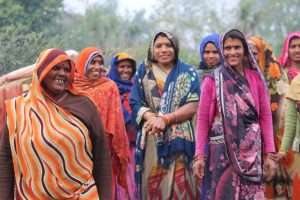 Jal Saheli collective of women water leaders supporting the implementation of PRAGATI in Uttar Pradesh
Jal Saheli collective of women water leaders supporting the implementation of PRAGATI in Uttar Pradesh
- Leading awareness creation initiatives and adoption of disruptive technologies and innovative financing as demonstrated in a pilot project by 2030 WRG in Nandurbar, Maharashtra, which focused on harnessing technologies such as drones, analytical tools and platforms for building climate resilience in agro forestry value chains, improving agri-productivity and enhancing farmer prosperity. Local NGOs and farmer groups were critical in mobilizing communities, educating them on benefits of technological and financial solutions, and facilitating cluster level implementation.
- Enhancing market access opportunities as demonstrated in a program by 2030 WRG and Water Resources Department, Government of Maharashtra. The program focused on integrated development in command areas[1] through off-farm water management, on-farm water use efficiency, and strengthening market linkages. Organizations such as WUAs, Farmer Producer Companies (FPCs), and cooperatives were instrumental in ensuring sustainable and fair access to markets for increased incomes and improved livelihoods.
While extension services have successfully facilitated water security in projects across India, scaling their impact for water efficiency has been challenging. Key recommendations to expand their impact are:
- Focus on developing and strengthening irrigation extension services by the Water Resources Departments in the State Governments to better utilize irrigation capacity and improve economic gains for farmers through more optimal use of resources.
- Transition extension services provided for water management from a knowledge to a more user-oriented model that supports and facilitates access to inputs, innovation, and information for farmers at the last mile.
- Shift from global and regional models of extension service-delivery to hyper-local, digital, on-demand and ready-to-deploy models through digital applications and data-driven products designed to increase agricultural productivity and water use efficiency (for example, Canal Digital Agri-food Ecosystem developed by WIDYA and implemented in Maharashtra[1]).
Strengthening our joint understanding of the climate-water nexus is the need of the hour and the time for concerted leadership and collective action is now!
Foot Notes:
[1]https://www.circleofblue.org/2018/world/groundwater-scarcity-pollution-set-india-on-perilous-course/
[2]https://www.germanwatch.org/sites/default/files/Global%20Climate%20Risk%20Index%202021_2.pdf
[3]https://www.oecd.org/india/India-Improving-Water-Security.pdf
[4]Water Stressed Districts, Government of India
[5]Composite Water Management Index, Niti Aayog 2019
[6]https://www.irjet.net/archives/V6/i4/IRJET-V6I4739.pdf
[7]https://www.thethirdpole.net/en/food/climate-change-drives-down-yields-and-nutrition-of-indian crops/#:~:text=India%2C%20home%20to%201.4%20billion,32%25%2D40%25%20in%20rice.
[8]https://www.oecd.org/india/India-Improving-Water-Security.pdf
[9]2030 WRG Annual Report 2021
[10]https://www.adb.org/sites/default/files/project-documents/53264/53264-001-rrp-en.pdf
[13]Economic Survey of Maharashtra 2021 -2022
[14]Project on Climate Resilient Agriculture
[15]Participatory Rural Agricultural Advancement through increased incomes
[16]These cumulative values are outcomes of efforts made under PRAGATI owing to initiatives undertaken by MGNREGA, a new technology initiative led by ag-tech partner, EF Polymer and local communities.
[17]https://www.fao.org/3/cc0347en/cc0347en.pdf

Meghana Rao Pahlajani, State Partnerships Coordinator – Maharashtra, 2030 WRG. She can be reached at Email: mpahlajani@worldbank.org
 Yogesh Bandhu Arya, State Partnerships Coordinator – Uttar Pradesh, 2030 WRG. He can be reached at Email: yarya@worldbank.org
Yogesh Bandhu Arya, State Partnerships Coordinator – Uttar Pradesh, 2030 WRG. He can be reached at Email: yarya@worldbank.org

Pia Barkataki, Partnerships Coordinator – UP Agri-Water Accelerator Program, 2030 WRG. She can be reached at Email: pbarkataki@worldbank.org

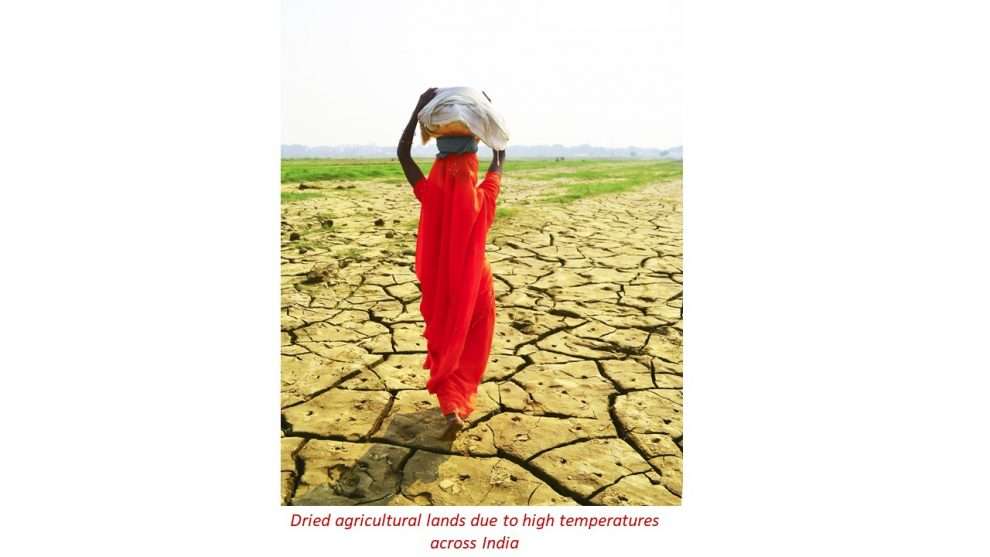

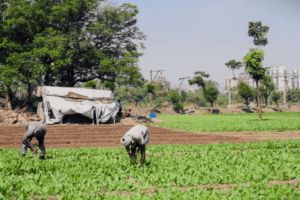

Add Comment